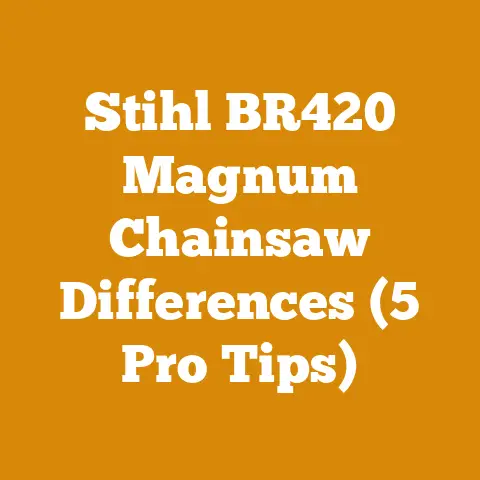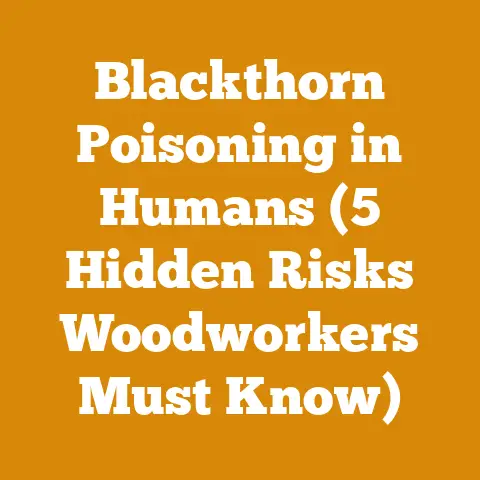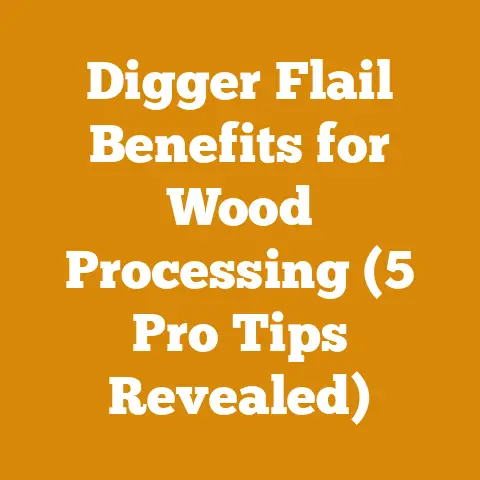Tiny Bugs That Leave Piles of Sawdust (Woodpile Pest ID Guide)
Saving Money While Protecting Your Woodpile: A Guide to Identifying and Eliminating Tiny, Sawdust-Making Bugs
I’m excited to share some hard-earned wisdom about a problem I think we all face: tiny bugs that leave piles of sawdust near our precious woodpiles.
I know firsthand how disheartening it is to see those little piles of “wood flour” forming next to your carefully stacked logs.
It’s not just about the wood being eaten; it’s about the potential for long-term structural damage, wasted effort, and ultimately, wasted money.
Understanding the Threat: Why Wood-Boring Insects Are a Problem
Before we get into the nitty-gritty of bug identification and control, it’s crucial to understand the scope of the problem.
Wood-boring insects are a global issue, affecting everything from backyard woodpiles to the structural integrity of buildings.
- Economic Impact: According to the USDA Forest Service, wood-destroying insects cause billions of dollars in damage annually in the United States alone.
This includes not just structural damage to homes but also losses in the timber industry and the cost of pest control treatments. - Hidden Damage: The real danger is that much of the damage caused by these insects is hidden from view.
They often work from the inside out, weakening the wood before any external signs are visible.
This can lead to catastrophic failures in structural components. - Spread of Infestations: An infestation in your woodpile can easily spread to other wooden structures on your property, including fences, sheds, and even your home.
Prevention is always better (and cheaper) than cure.
Identifying the Culprits: Common Wood-Boring Insects in Woodpiles
Okay, so we know there’s a problem.
Now, who are the usual suspects?
Let’s take a look at some of the most common wood-boring insects you might encounter in your woodpile:
Powderpost Beetles
These are probably the most common culprits.
Powderpost beetles are small (1/8 to 3/4 inch long) and reddish-brown to black.
Their larvae bore into wood, creating tiny tunnels filled with very fine, powdery sawdust.
- Signs of Infestation: The most obvious sign is the presence of small (1-2 mm) exit holes in the wood surface, often accompanied by piles of fine, powdery sawdust (hence the name “powderpost”).
The wood itself may feel light and brittle. - Wood Preference: Powderpost beetles are particularly fond of hardwoods like oak, ash, and hickory.
They often infest seasoned lumber and furniture. - Life Cycle: The female beetle lays her eggs in the pores of the wood.
The larvae hatch and begin to feed on the wood, tunneling through it for several months to a year.
They then pupate within the wood before emerging as adults.
Carpenter Ants
Carpenter ants don’t actually eat wood; they excavate it to create nests.
However, their tunneling can cause significant structural damage.
- Signs of Infestation: Look for piles of coarse sawdust mixed with insect parts (ant bodies and wings).
You may also hear a rustling sound within the wood.
Carpenter ants often create smooth, clean tunnels in the wood. - Wood Preference: Carpenter ants prefer damp or decaying wood, but they will also infest sound wood.
They are commonly found in window frames, door frames, and other areas prone to moisture. - Distinguishing Feature: Unlike termites, carpenter ants do not eat the wood.
They simply remove it to create their nests.
The sawdust they produce is coarser than that of powderpost beetles and often contains insect parts.
Termites
These are the heavy hitters.
Termites are social insects that live in colonies.
They feed on cellulose, the main component of wood, and can cause extensive damage to wooden structures.
- Signs of Infestation: Mud tubes are a telltale sign of termites.
These are tunnels made of soil, saliva, and feces that termites use to travel between their nest and the wood they are feeding on.
Other signs include hollow-sounding wood, sagging floors, and damaged drywall. - Wood Preference: Termites will feed on almost any type of wood, but they prefer softwoods like pine and fir.
They are particularly attracted to damp or decaying wood. - Types of Termites: There are several types of termites, including subterranean termites, drywood termites, and dampwood termites.
Subterranean termites are the most common and destructive.
Wood-Boring Weevils
These beetles are smaller than powderpost beetles and often have a distinctive snout.
Their larvae bore into wood, creating tunnels that are filled with sawdust.
- Signs of Infestation: Look for small exit holes in the wood surface, often accompanied by piles of sawdust.
The wood itself may feel spongy or crumbly. - Wood Preference: Wood-boring weevils infest both hardwoods and softwoods.
They are often found in damp or decaying wood. - Life Cycle: The female weevil lays her eggs in cracks or crevices in the wood.
The larvae hatch and begin to feed on the wood, tunneling through it for several months.
They then pupate within the wood before emerging as adults.
Bark Beetles
These small beetles primarily attack trees, but they can also infest freshly cut logs with bark still attached.
- Signs of Infestation: Look for small holes in the bark of the wood, often accompanied by sap or resin oozing from the holes.
You may also see winding galleries under the bark. - Wood Preference: Bark beetles prefer weakened or stressed trees.
They are often attracted to freshly cut logs that have not been properly dried. - Impact on Firewood: Bark beetles don’t typically damage the wood itself, but their presence can make the wood unsightly and difficult to handle.
Understanding the “Sawdust”
The type of sawdust left behind can give you clues about the insect involved.
- Fine, Powdery Sawdust: This is characteristic of powderpost beetles.
The sawdust is very fine and feels like flour. - Coarse Sawdust with Insect Parts: This is characteristic of carpenter ants.
The sawdust is coarser than that of powderpost beetles and often contains insect parts. - Mud-Like Debris: This is associated with termites.
Termites often leave behind a mixture of soil, saliva, and feces, which can resemble mud. - Spongy, Crumbly Wood: This can be caused by wood-boring weevils.
The wood may feel spongy or crumbly to the touch.
My Personal Encounters with Wood-Boring Insects
Over the years, I’ve had my fair share of run-ins with these wood-devouring pests.
One particularly memorable experience involved a massive oak tree that I had felled for firewood.
I left the logs stacked in the woods for a few months, intending to split them later.
Big mistake!
When I finally got around to it, I discovered that powderpost beetles had already moved in and were having a feast.
The outer layers of the wood were riddled with tiny holes, and the sawdust was everywhere.
I ended up losing a significant portion of the wood to those little buggers.
That experience taught me a valuable lesson: don’t let your guard down, and inspect your wood regularly.
Prevention is Key: Protecting Your Woodpile from Infestation
Okay, now that we know who the enemies are, let’s talk about how to defend our woodpiles.
Prevention is always the best strategy.
Here are some steps you can take to protect your wood from infestation:
Proper Wood Storage
- Elevate the Wood: Store your wood on a rack or pallets to keep it off the ground.
This will improve air circulation and prevent moisture from accumulating, making the wood less attractive to insects.- Data Point: Wood stored off the ground dries up to 50% faster, reducing the risk of fungal growth and insect infestation.
- Location, Location, Location: Choose a storage location that is away from your home and other wooden structures.
This will help prevent the infestation from spreading. - Sunlight and Airflow: Store your wood in a sunny location with good air circulation.
Sunlight helps to dry the wood, making it less attractive to insects.
Good airflow helps to prevent moisture from accumulating. - Clear the Area: Keep the area around your woodpile clear of vegetation and debris.
This will help to reduce the humidity and make it less attractive to insects. - Stacking Method: Stack your wood loosely to allow for good air circulation.
Avoid tightly packing the wood, as this can trap moisture.
Wood Selection and Preparation
- Seasoned Wood: Use seasoned wood whenever possible.
Seasoned wood has a lower moisture content, making it less attractive to insects.- Data Point: Seasoning wood for 6-12 months can reduce its moisture content from 50% to 20%, making it significantly less attractive to wood-boring insects.
- Debarking: Remove the bark from the wood.
Bark provides a hiding place for insects and also traps moisture. - Wood Species: Choose wood species that are naturally resistant to insects.
Some woods, like cedar and redwood, contain natural oils that repel insects.- Unique Insight: Eastern Red Cedar is known for its aromatic oils that naturally deter many insects, including moths and some wood-boring beetles.
- Kiln-Dried Wood: If possible, use kiln-dried wood.
Kiln drying kills any insects that may be present in the wood.
Inspection and Monitoring
- Regular Inspections: Inspect your woodpile regularly for signs of infestation.
Look for exit holes, sawdust, and other signs of insect activity. - Trap Placement: Consider using insect traps to monitor for insect activity.
These traps can help you to detect infestations early, before they cause significant damage. - Sound Test: Tap the wood with a hammer or other tool.
Hollow-sounding wood may indicate insect damage.
Treatment Options: When Prevention Isn’t Enough
Despite our best efforts, sometimes insects still find their way into our woodpiles.
When this happens, we need to take action to control the infestation.
Here are some treatment options:
Chemical Treatments
- Borate-Based Insecticides: Borate-based insecticides are effective against a wide range of wood-boring insects.
They are relatively non-toxic to humans and pets, making them a good choice for treating woodpiles.- Application: Apply the insecticide to the surface of the wood, making sure to saturate all areas.
You may need to reapply the insecticide periodically, depending on the severity of the infestation.
- Application: Apply the insecticide to the surface of the wood, making sure to saturate all areas.
- Synthetic Pyrethroids: Synthetic pyrethroids are another option for treating wood-boring insects.
They are more toxic than borate-based insecticides, so use them with caution.- Safety Precautions: Always follow the manufacturer’s instructions carefully when using synthetic pyrethroids.
Wear protective clothing, including gloves, a mask, and eye protection.
- Safety Precautions: Always follow the manufacturer’s instructions carefully when using synthetic pyrethroids.
- Fumigation: Fumigation is a more aggressive treatment option that involves sealing the woodpile in a tent and releasing a fumigant gas.
This method is effective against all types of wood-boring insects, but it is also more expensive and requires specialized equipment and training.- Professional Application: Fumigation should only be performed by a licensed pest control professional.
Non-Chemical Treatments
- Heat Treatment: Heat treatment involves heating the wood to a temperature that is lethal to insects.
This can be done using a kiln or a portable heat chamber.- Data Point: Heating wood to 130°F (54°C) for 30 minutes will kill most wood-boring insects.
- Freezing: Freezing can also be used to kill insects in wood.
This involves placing the wood in a freezer for several days.- Practical Consideration: This method is only practical for small pieces of wood.
- Solarization: Solarization involves covering the woodpile with a clear plastic tarp and exposing it to direct sunlight.
The heat from the sun will kill the insects.- Effectiveness: This method is most effective in hot, sunny climates.
- Beneficial Nematodes: Beneficial nematodes are microscopic worms that parasitize insects.
They can be applied to the woodpile to control wood-boring insects.- Environmental Benefit: Beneficial nematodes are a natural and environmentally friendly way to control insect pests.
My “Baking” Experiment with Infested Firewood
I once had a small batch of firewood that was infested with powderpost beetles.
I didn’t want to use chemical treatments, so I decided to try a DIY heat treatment.
I wrapped the wood in black plastic and left it in the sun for several days during the hottest part of the summer.
The temperature inside the plastic reached well over 130°F (54°C).
After a week, I unwrapped the wood and inspected it.
The beetles were gone!
It was a simple and effective way to get rid of the infestation.
Important Note: While this method worked for me on a small scale, it’s essential to monitor the temperature carefully and ensure that the wood is heated evenly.
This method is not suitable for large woodpiles or for wood that is already severely damaged.
Choosing the Right Treatment: A Decision-Making Guide
Choosing the right treatment option depends on several factors, including the type of insect, the severity of the infestation, and your personal preferences.
Here’s a decision-making guide:
- Light Infestation: If you only see a few exit holes or a small amount of sawdust, you may be able to control the infestation with non-chemical treatments like heat treatment or freezing.
- Moderate Infestation: If the infestation is more widespread, you may need to use chemical treatments like borate-based insecticides or synthetic pyrethroids.
- Severe Infestation: If the wood is severely damaged or the infestation is widespread, you may need to consider fumigation or replacing the wood altogether.
- Environmental Concerns: If you are concerned about the environmental impact of chemical treatments, you may want to consider using non-chemical treatments like beneficial nematodes or solarization.
- Cost: The cost of treatment can vary widely depending on the method used.
Non-chemical treatments are generally less expensive than chemical treatments, but they may not be as effective.
Safety First: Protecting Yourself During Treatment
When treating wood-boring insects, it’s essential to take safety precautions to protect yourself from exposure to chemicals and other hazards.
- Read the Label: Always read and follow the manufacturer’s instructions carefully when using any type of insecticide.
- Protective Clothing: Wear protective clothing, including gloves, a mask, and eye protection, when applying insecticides.
- Ventilation: Work in a well-ventilated area to avoid inhaling insecticide fumes.
- Food and Drink: Do not eat, drink, or smoke while applying insecticides.
- Children and Pets: Keep children and pets away from treated areas until the insecticide has dried.
- Disposal: Dispose of empty insecticide containers properly, following the manufacturer’s instructions.
Long-Term Strategies: Maintaining a Pest-Free Woodpile
Once you’ve eliminated the infestation, it’s essential to take steps to prevent it from returning.
Here are some long-term strategies:
- Regular Inspections: Continue to inspect your woodpile regularly for signs of insect activity.
- Proper Storage: Maintain proper wood storage practices, including elevating the wood, choosing a sunny location, and clearing the area around the woodpile.
- Seasoned Wood: Use seasoned wood whenever possible.
- Debarking: Remove the bark from the wood.
- Preventative Treatments: Consider applying preventative treatments to your woodpile periodically to deter insects.
- Monitor Moisture Levels: Use a moisture meter to monitor the moisture content of your wood.
Keep the moisture content below 20% to prevent insect infestations.
Case Study: A Firewood Producer’s Struggle with Termites
I know a local firewood producer who had a major problem with termites.
His woodpiles were located near a wooded area, and the termites were constantly infesting his wood.
He tried various treatments, but nothing seemed to work.
Finally, he decided to move his woodpiles to a more open area and elevate them off the ground.
He also started using borate-based insecticides as a preventative measure.
These steps significantly reduced the termite infestation and saved his business from financial ruin.
The Global Perspective: Wood-Boring Insects Around the World
Wood-boring insects are a global problem, affecting wood resources in many countries.
Different regions face different challenges, depending on the climate, the types of wood available, and the local insect species.
- Tropical Regions: Tropical regions are particularly vulnerable to wood-boring insects due to the warm, humid climate.
Termites are a major problem in these areas. - Temperate Regions: Temperate regions also experience wood-boring insect infestations, but the types of insects and the severity of the infestations can vary depending on the region.
- Developing Countries: In developing countries, the lack of resources and access to effective treatments can make it difficult to control wood-boring insects.
This can lead to significant economic losses.
The Future of Wood Preservation: Innovations and Trends
The field of wood preservation is constantly evolving, with new technologies and treatments being developed to protect wood from insects and decay.
Some of the key trends include:
- Inspect your woodpile regularly for signs of infestation.
- Store your wood off the ground in a sunny location with good air circulation.
- Use seasoned wood whenever possible.
- Remove the bark from the wood.
- Consider using borate-based insecticides as a preventative measure.
- Monitor the moisture content of your wood.
- Take action immediately if you detect an infestation.
Final Thoughts: A Commitment to Sustainable Wood Management
Protecting our woodpiles from wood-boring insects is not just about saving money; it’s also about promoting sustainable wood management.
By preventing wood waste, we can reduce the demand for new timber and help to conserve our forests.
So, let’s all commit to taking the necessary steps to protect our woodpiles from these destructive pests and ensure that our wood resources are used wisely.
After all, a little prevention goes a long way, and a well-protected woodpile is a happy woodpile!






